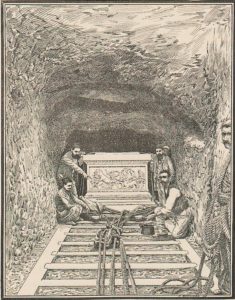Sebastian Willert (Technische Universität Berlin)
KCultural Imperialism versus Protectionism? On the Role of Antiquities as a matter of conflict within the German-Ottoman Art Policy between 1890 and 1918

Extraction du Grand Sarcophage (no 7): Osman Hamdi Bey/Theodor Reinach: Une nécropole royale à Sidon. Fouilles de Hamdy Bey, Paris 1892, S. 60.
On November 15, 1899, the German and Ottoman Empires concluded through an exchange of notes between the German Embassy and the Ottoman Foreign Ministry in Istanbul a treaty that was binding under international law. According to the Berlin museum representatives who initiated the agreement, it was intended to secure for the Royal Museums the export of ancient objects retrieved from archaeological excavations in the Ottoman Empire. However, the Müze-i Hümayun (Imperial Museum) did not accept the agreement and pursued various strategies to prevent it from being implemented. The dispute between German and Ottoman scholars dominated German-Ottoman cultural politics and culminated in interventions by Wilhelm II and Sultan Abdülhamid II.
Against the backdrop of divergent perceptions of the existence of the treaty and a growing rivalry over the possession of prestigious antiquities that became increasingly apparent in the 19th century, the dissertation project analyzes the role ancient objects played in German-Ottoman relations. To what extent did the export of objects and the related negotiations as well as the valorization of cultural property affect diplomatic relations? What strategies and methods did actors pursue to bring ancient objects and cultural property from the Ottoman Empire to Berlin? The focus is on the German and Ottoman actors, their discourses on the granting of excavation permits and the division of finds, the Ottoman Laws on Antiquities, and the bilateral tensions generating cultural objects and excavations themselves.
